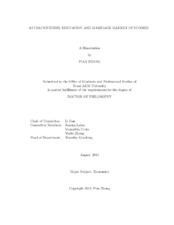| dc.description.abstract | This dissertation studies the interrelationship among attractiveness, education and marriage market outcomes.
In Section 2, I first examine individuals attractiveness in four dimensions: anthropometric measures (e.g. height and BMI), physical attractiveness, personality attractiveness and grooming, using a unique data set called Add Health. I find that height has positive effects on men's perceived physical attractiveness, but no significant non-zero effects on women. A higher BMI decreases an individual's physical attractiveness on average. However, if the square of BMI is considered, it is shown that thinner women, and stronger men have higher ratings of physical attractiveness. Physical attractiveness, personality attractiveness and grooming are positively correlated with each other. Then I studied how the four attractiveness measures affect peoples socioeconomic outcomes simultaneously. I find that, with all dimensions of attractiveness considered, physical attractiveness still has significant effects on individuals' earnings and spouses' education. Finally, I investigate the source of the penalty and premia of grooming in the labor market. The DID model provides some evidence that there exists general employer discrimination against bad looks.
Section 3 studies pre-marital education investment strategies developed by heterogeneous individuals. People with different attributes or marriage incentives form different marriage prospects when making their college decisions, which leads to distinct investment strategies. Overall, people with lower abilities are less likely to go to college than their high-ability cohorts. Low-ability individuals who value current wealth and expected future earnings in a relationship (“marrying-for-money” type) are more likely to go to college than their cohorts who prefer desirable attributes or matching qualities (“marrying-for-love” type). Empirically, this paper adopts the mixture density model to capture the unobserved types of marriage incentives. Data from National Longitudinal Study of Adolescent Health provides supportive evidence. It is estimated that there are over 60 percent of people who belong to the “marrying-for-money” type in the sample. The “marrying-for-love” type of people have higher percentages of attending college on average. | en |


